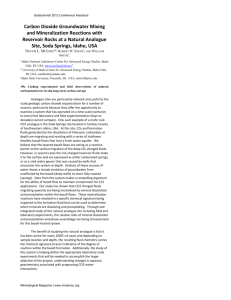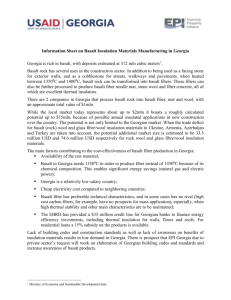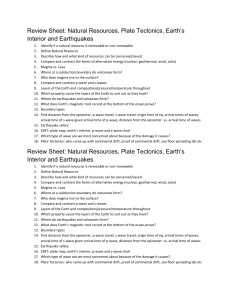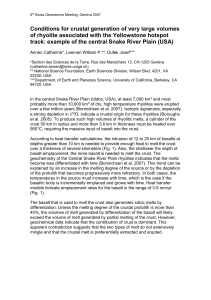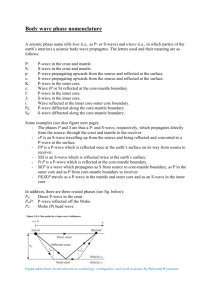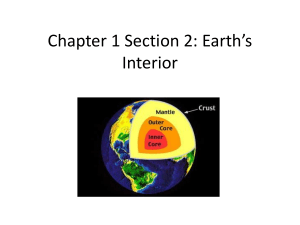Sub-basalt imaging - west of Hebrides
advertisement
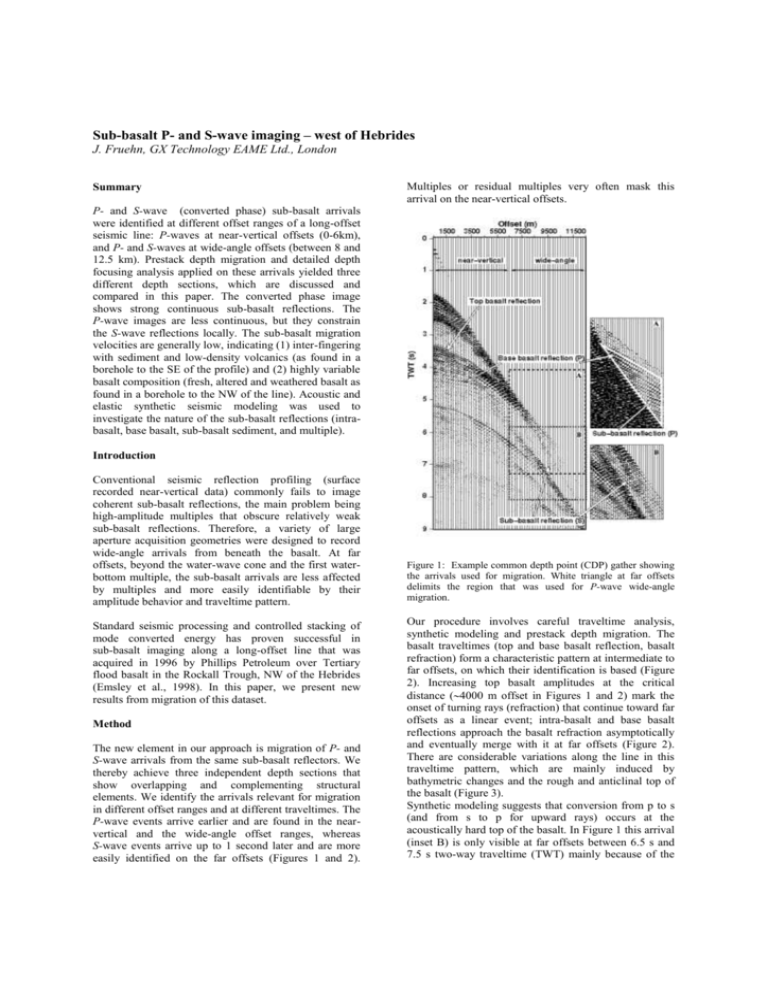
Sub-basalt P- and S-wave imaging – west of Hebrides J. Fruehn, GX Technology EAME Ltd., London Summary Multiples or residual multiples very often mask this arrival on the near-vertical offsets. P- and S-wave (converted phase) sub-basalt arrivals were identified at different offset ranges of a long-offset seismic line: P-waves at near-vertical offsets (0-6km), and P- and S-waves at wide-angle offsets (between 8 and 12.5 km). Prestack depth migration and detailed depth focusing analysis applied on these arrivals yielded three different depth sections, which are discussed and compared in this paper. The converted phase image shows strong continuous sub-basalt reflections. The P-wave images are less continuous, but they constrain the S-wave reflections locally. The sub-basalt migration velocities are generally low, indicating (1) inter-fingering with sediment and low-density volcanics (as found in a borehole to the SE of the profile) and (2) highly variable basalt composition (fresh, altered and weathered basalt as found in a borehole to the NW of the line). Acoustic and elastic synthetic seismic modeling was used to investigate the nature of the sub-basalt reflections (intrabasalt, base basalt, sub-basalt sediment, and multiple). Introduction Conventional seismic reflection profiling (surface recorded near-vertical data) commonly fails to image coherent sub-basalt reflections, the main problem being high-amplitude multiples that obscure relatively weak sub-basalt reflections. Therefore, a variety of large aperture acquisition geometries were designed to record wide-angle arrivals from beneath the basalt. At far offsets, beyond the water-wave cone and the first waterbottom multiple, the sub-basalt arrivals are less affected by multiples and more easily identifiable by their amplitude behavior and traveltime pattern. Standard seismic processing and controlled stacking of mode converted energy has proven successful in sub-basalt imaging along a long-offset line that was acquired in 1996 by Phillips Petroleum over Tertiary flood basalt in the Rockall Trough, NW of the Hebrides (Emsley et al., 1998). In this paper, we present new results from migration of this dataset. Method The new element in our approach is migration of P- and S-wave arrivals from the same sub-basalt reflectors. We thereby achieve three independent depth sections that show overlapping and complementing structural elements. We identify the arrivals relevant for migration in different offset ranges and at different traveltimes. The P-wave events arrive earlier and are found in the nearvertical and the wide-angle offset ranges, whereas S-wave events arrive up to 1 second later and are more easily identified on the far offsets (Figures 1 and 2). Figure 1: Example common depth point (CDP) gather showing the arrivals used for migration. White triangle at far offsets delimits the region that was used for P-wave wide-angle migration. Our procedure involves careful traveltime analysis, synthetic modeling and prestack depth migration. The basalt traveltimes (top and base basalt reflection, basalt refraction) form a characteristic pattern at intermediate to far offsets, on which their identification is based (Figure 2). Increasing top basalt amplitudes at the critical distance (4000 m offset in Figures 1 and 2) mark the onset of turning rays (refraction) that continue toward far offsets as a linear event; intra-basalt and base basalt reflections approach the basalt refraction asymptotically and eventually merge with it at far offsets (Figure 2). There are considerable variations along the line in this traveltime pattern, which are mainly induced by bathymetric changes and the rough and anticlinal top of the basalt (Figure 3). Synthetic modeling suggests that conversion from p to s (and from s to p for upward rays) occurs at the acoustically hard top of the basalt. In Figure 1 this arrival (inset B) is only visible at far offsets between 6.5 s and 7.5 s two-way traveltime (TWT) mainly because of the Sub-basalt imaging – west of Hebrides strong multiples at near offsets. However, Figure 2 shows that even without multiples the converted wave, base (S), is difficult to identify because the amplitudes are very low in the near-vertical range. They start increasing at intermediate offsets. The wide-angle P-wave image (Figure 3c) was calculated from the arrivals beyond the water-wave cone only (white triangle in Figure 1). The section exhibits strong sub-basalt reflections between CDP 300 and CDP 1000 (coincident with the S-wave reflection) and, at greater depth, bright reflections (SB4) from the far offsets of the gathers. Figure 2: Synthetic CDP gather showing basalt arrivals; wb=water bottom, base(S) is the converted phase reflected off the base basalt. The main contribution to our study however, comes from the SIRIUS™ imaging loop, which consists of a Kirchhoff-type prestack depth migration scheme (PSDM) and depth-focusing analysis (DFA). The interactiveness of DFA allows us to assess the effect of velocity changes on the common reflection point (CRP) gathers in real time. In a top-to-bottom approach, the optimal migration velocities are updated iteratively and are closely linked to the imaged structures (velocity boundaries and imaged horizons are coincident). Finite difference migration was also tested and compared with the Kirchhoff results. Additional constraints on the nature of the sub-basalt reflections were taken from synthetic modeling that was mainly used to exclude a number of the most common multiples that may have been imaged. Examples The images shown in Figure 3 result from several iterations of combined PSDM and DFA. The S-wave image shows a strong top of the basalt (Figure 3a TB) and three, largely continuous, sub-basalt reflections (SB1-SB3). The basalt S-wave migration velocities vary between 1600 m/s and 2300 m/s along the line. The near-vertical P-wave image (Figure 3b) shows only few sub-basalt reflections, most continuously between CDP 1250 and CDP 1750. Here, P- and S-wave images are almost coincident (white dashed line is SB3 from S-wave image). Velocities range between 3900 m/s and 4200 m/s. Figure 3: PSDM of P- and S-wave arrivals; (a) migration with S-wave velocities, (b) and (c) migration with P-wave velocities. White dashed line is SB3 from S-wave image. The migration velocities are generally low compared with basalt velocities found elsewhere along the North Atlantic margin e.g., Faeroe-Shetland basalt (Fruehn et Sub-basalt imaging – west of Hebrides al., 1999). Regional boreholes, however, show that the basalt from the West Hebrides area consist of various volcanic facies (tuffs, fresh, altered, weathered basalt, sills), with seismic velocities ranging between 4000 m/s and 5500 m/s. Additionally, the volcanic units closer to the continent show strong inter-fingering with sediment (tuffaceous siltstone), which lowers the average seismic velocities even more (3500-4500 m/s). Similarly low velocities were reported from the Møre basin where flood basalt inter-fingers with sediment (Planke et al., 1999). Conclusions The most continuous sub-basalt image was obtained from migration with S-wave velocities. The P-wave migrations, however, can be used to constrain this image by providing independent evidence of the same reflectors. Superimposing the sub-basalt horizon SB3, as imaged in the S-wave migration, on the P-wave sections (dashed line in Figures 3b and 3c), we observe locally continuous P-wave reflections at similar depths. The near-vertical P-wave section (Figure 3b) constrains the S-wave image in the SE, and the wide-angle P-wave image (Figure 3c) in the NW. Additionally, the wide-angle migration images a very deep arrival (SB4), probably reflected off the underlying Lewisian basement that was drilled in a borehole to the NE of the profile. The relatively low migration velocities are in agreement with regional borehole information showing inhomogeneous basalt composition. Data analysis suggests SB3 to be the base of the basalt. Synthetic modeling has helped to exclude a number of multiples, which potentially could have been migrated. References Emsley D., Boswell, P. and P. Davis, Sub-basalt imaging using long offset reflection seismic data, Extended abstracts to the 60th EAGE Conference and Technical Exhibition, 8-12 June 1998, Leipzig, Germany 1998. Fruehn J., White, R. S., Fliedner, M., Richardson, K. R., Cullen, E., Latkiewicz, C., Wayne, K. and J. Smallwood, Large-aperture seismic: Imaging beneath high-velocity strata, World Oil, vol. 220, no. 1, 109113, 1999. Planke, S., Alvestad, E., and O. Eldholm, Seismic characteristics of basaltic extrusive and intrusive rocks, The Leading Edge, vol. 18, no. 3, 342-348, 1999.

